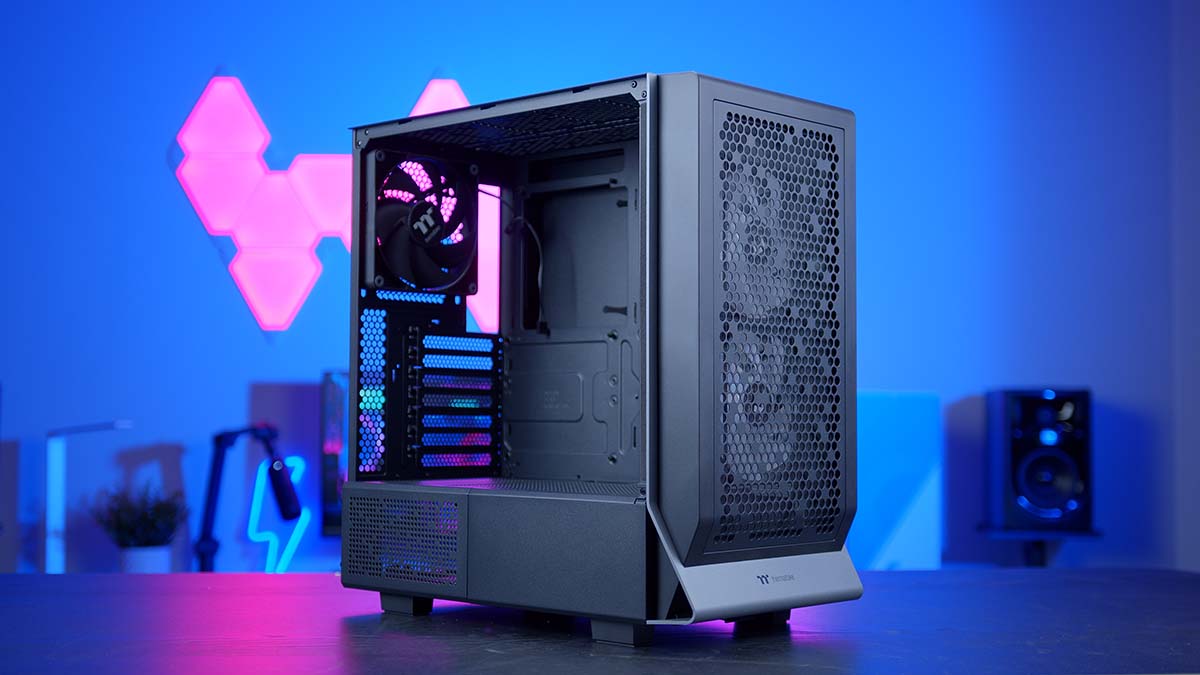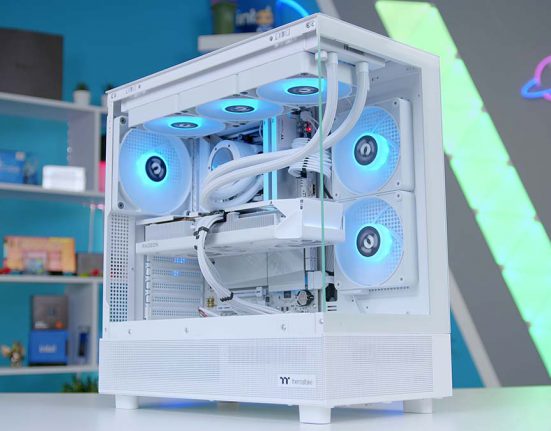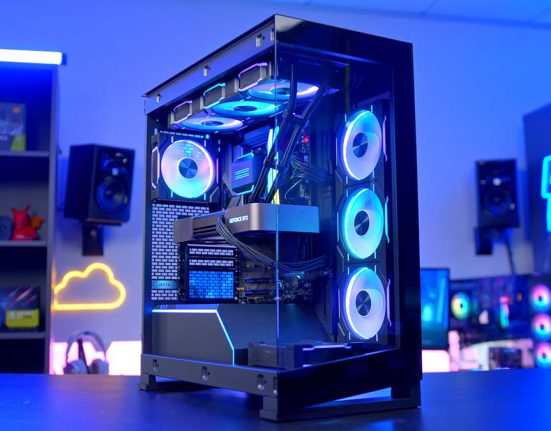Introduction
Thermaltake is well known in the PC hardware space for their robust and versatile case designs. We’ve reviewed a number of their chassis that have come into the GeekaWhat office, and for the most part, Thermaltake seems to offer consistently solid options that cater to a range of different use-cases.
Whether you’re an enthusiast looking to secure a full-tower chassis for custom liquid cooling, or you need a small form factor case to hide away out of sight, Thermaltake have you covered. But what are your options if you need a smaller budget case? In this review we’ll be doing a deep dive on a chassis that fits these exact prerequisites – the Ceres 300 TG ARGB.
This small but interesting case comes in at a solid price point, and sports a great set of features for said price. We’ll be taking a look at the Ceres 300 in detail, highlighting various design elements that make this a great case worth considering.
Buy the Thermaltake Ceres 300 TG ARGB on:
Thermaltake Ceres 300 Design & Aesthetic
The Ceres 300 is a relatively standard-looking mid-tower case, adhering to the ‘metal box’ aesthetic. Despite this, there’s a couple of design features worth noting that spice up the look of this case slightly. The first area of note is the perforated front panel. I think the hexagonal design on the front panel looks great, while also providing users with more airflow. This provides a pretty unrestricted view of the pre-installed 140mm RGB fans at the front of the case, which add some flair to your build while aiding with thermals.

One of the other design aspects worth mentioning is the rest of the perforations around the case. Again, this should assist with airflow, but it adds some nice depth to the look. Thermaltake have clearly shifted their focus to airflow within this case, and its great to see a manufacturer make this leap by providing more ventilation.
| Thermaltake Ceres 300 TG ARGB | Specification |
|---|---|
| Case Size | Mid-Tower |
| Pre-Installed Fans | Front: 2x CT140 ARGB Rear: 1x CT140 ARGB |
| Max Fan Support | 7x 120mm |
| Max Radiator Support | Front: Up to 360mm Top: Up to 280mm Rear: Up to 120mm |
| Motherboard Support | Up to E-ATX |
| GPU Clearance | 370mm |
| CPU Cooler Clearance | 185mm |
| Front IO | 1x USB 3.2 Gen2 Type-C 1x USB 3.0 x2 1x 3.5mm Combo Jack |
The Ceres 300 TG ARGB does come in a range of colours to choose from. Although we’ve highlighted the grey version within this review, the Matcha Green, or white alternatives will appeal to those looking for a different aesthetic.


While the overall design of the Ceres 300 is a bit lacklustre, there are a number of ways to make a build within this chassis look awesome. The optional LCD panel kit is a good start, along with some additional RGB components, such as fans or a liquid cooler. Regardless, the Ceres 300 looks to focus primarily on airflow, which is likely why the aesthetic isn’t that impressive, but at its price point I feel this is perfectly fine.
Suggested Article: Deepcool AK620 Digital Review
Building in the Ceres 300 TG ARGB
While the Ceres 300 is a relatively simplistic looking case, building in this chassis is a breeze. We put a full build together with this chassis highlighting all of the major specifications that the Ceres 300 offers. We’ve discussed them below.
Internal Space
Despite being a more compact chassis, the Ceres 300 TG ARGB offers a vast amount of space for large components. This includes 370mm of graphics card clearance, and 185mm of space for a CPU cooler. This means installing an RTX 4000 option, or perhaps a big air cooler shouldn’t pose any installation issues, or restrict airflow.
Airflow is further complimented by the amount of ventilation and perforations that can be seen on this case, which we’ve discussed further in the features section. It is worth noting that any cables can be fed through the cutouts located towards the right of the case, which are protected with rubber grommets.

In terms of motherboard support, the Ceres 300 offers support up to E-ATX options measuring 12 inches by 13 inches at the maximum. This means you’ll be able to install even the biggest E-ATX motherboards. We opted to use an ATX option for this particular build, but you can see the additional motherboard standoff holes for E-ATX boards located towards the right side of the case.

Radiator and Fan Mounting
Looking at cooling solutions, the Ceres 300 TG ARGB offers a vast amount of space for radiators at the top and the front of the case. Underneath the magnetic dust cover, you’ll find a rather wide mounting system, which can support up to 280mm AIOs, three 120mm fans, or two 140mm fans. Thanks to the width of this chassis, collision or clearance shouldn’t be an issue here, allowing you to easily install your radiator without any worries.
Cable management is a slight concern here, as you are restricted to one larger hole at the back of the case, and a smaller cutout at the front corner. But some creativity should help you here.

At the front of the Ceres 300 TG ARGB you’ll find two pre-installed 140mm RGB fans. The front panel supports up to 360mm liquid cooling radiators, three 120mm fans, or two 140mm fans. This provides you with an ample amount of configuration options for cooling. We decided to relocate the 140mm fans at the front, and moved them to the top, opting to install a 360mm radiator for a push/pull configuration with air being ventilated through the rear of the case.

Dust Protection
The Thermaltake Ceres 300 TG ARGB has a mass of ventilation around the entire chassis, so dust protection will be an obvious concern for many. Fortunately, this case provides a number of different filters minimising any dust clogging up fans or your radiator. At the front and top of the Ceres 300, find magnetic filters which simply slot into their respective cutouts. We did find that the magnets were a bit weak resulting in the filters popping out during movement, but this shouldn’t be a major issue if your case is going to be mostly stationary.

Features We Like
In this section of the article we’ll be delving into the main features of the Ceres 300 TG ARGB. We’ve highlighted the features that we like and don’t like, allowing you to forge a general overview of this chassis.
All the Perforations!
As we’ve alluded to above, the Thermaltake Ceres 300 is covered in perforations across the entirety of the chassis. The top and front of the case feature a hex-grid design, which is backed by a dust filter. This ensures the air flowing through the case doesn’t clog your system with dust. The bottom of the Ceres 300 and the PSU shroud also offer some further perforations allowing your PSU to breathe during usage.

The opposing side panel also has a ventilated cut out too, which should assist with airflow around the cable management area of the chassis. It is worth noting as well that this vent does have a dust filter behind it too.
Rotational PCI-E Slots
Towards the rear of the case, you’ll find a set of PCI-E slots that can be fully rotated. This allows you to install your GPU using a traditional mounting method, or with a riser cable you can install your GPU vertically. Its nice to see that consumers have the choice between these two options, as it provides some alternative styling ideas for your PC build.

Comes with Three Pre-Installed Fans
The Thermaltake Ceres 300 comes with three 140mm fans pre-installed within the case. The two at the front are RGB options, and the fan at the rear doesn’t offer any lighting. These included fans will help with airflow, whilst also offering some additional aesthetic choices for your PC build. It is a shame that the rear fan isn’t RGB, but again, I don’t imagine this will be a deal-breaker for most consumers.

Features We Don’t Like
LCD Panel Kit Isn’t Included
The Ceres 300 is a pretty well-rounded case from what I can see, but there’s one feature (or lack thereof) that does need to be addressed. Thermaltake showcase the Ceres 300 with an LCD panel, which unfortunately isn’t included with the case. While I do understand that the LCD panel would bump up the cost of the chassis a bit, but I feel Thermaltake would have been better off providing an “LCD edition” of the Ceres 300 (which is something we’ve seen with other manufacturers like Deepcool). Doing this would allow Thermaltake to charge a bit extra for the case, as opposed to $100 for what is a 3.9″ screen.

Conclusion
Thermaltake Ceres 300 TG ARGB

Product Name: Ceres 300
Brand: Thermaltake
-
Features
-
Design
-
Versatility
-
Value For Money
Summary
Thermaltake’s Ceres 300 TG ARGB case may be one of the strongest value options to release in 2023. The mass of perforations and ventilation situated around this chassis provides a plethora of ways to ensure thermals are optimal across all of your components. There are few cases that offer such a solid ventilated chassis at this price point, which is why the Ceres 300 is such a great case. It caters to a mass of different consumers in terms of its component support, with plenty of internal space for large radiators, more fans, and even E-ATX motherboards. This also synergises well with the rotational PCI-E slots that allow you to change the look of your PC build with some alternative GPU mounting options.
There are a couple of criticisms that I have in terms of the design. This case isn’t very ‘showy’ and adheres to a relatively traditional case design that doesn’t ‘think out of the box’. So we wouldn’t recommend this case for lovers of RGB, or for those that need something more sophisticated. But I think the rugged design of the Ceres 300 is likely to appeal to many consumers despite this. The fact that the LCD panel isn’t included is a bit frustrating, considering how expensive it is to buy on its own. But this aside, it isn’t a necessity for a PC build, so this won’t be a deal-breaker for many users. Overall, I think the Ceres 300 is extremely strong, especially because this is a sub-$100 case. If you’re being a bit more restrictive with your budget, the Ceres 300 TG ARGB is a chassis that we’d be happy recommending.
Pros
✅ Comes with three-preinstalled RGB fans.
✅ Huge focus on airflow.
✅ Offers adjustable GPU mounting options.
Cons
❌ LCD panel isn’t included, very expensive to buy on its own.
❌ Overall aesthetic is quite lacklustre.
❌ Rear fan isn’t RGB.








